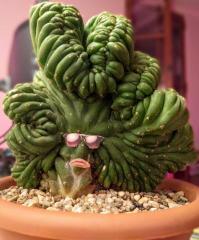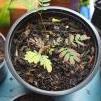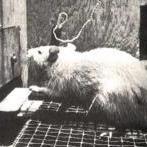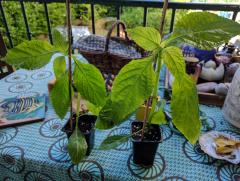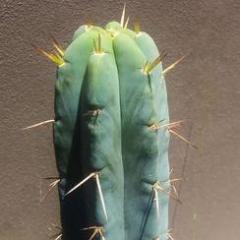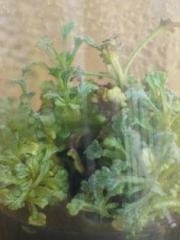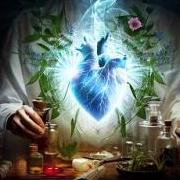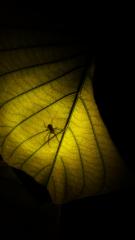Leaderboard
Popular Content
Showing content with the highest reputation on 21/03/18 in all areas
-
3 pointsI went to the local botanical garden today for a visit about poisonous plants. The visit itself was pretty good, although the guy fucking butchered Banisteriopsis as "Basteniros" or something like that, and at one point the dude whipped a potted loph out of his hand bag (I kid you not) and called it "Lophophora williamson". Mainly showed us some Apocynaceae vines, a couple Solenaceae, some Dieffencbachia, Laurel, Yew, etc... He showed us an Apocynaceae he said some shamans use as an admixture to ayahusca, the name escapes me at the moment and I forgot to take a pic. He showed us their Erythroxylum coca tree which got fucking raped by some mongrels, he said last year it was over 2m tall, there's now only a small 50cm or so shrub left... Anyways, the plants I was most hyped about weren't mentioned, found them by strolling around. here are some pics: - Psychotria peduncularis, wasn't able to ask for a leaf unfortunately but I will come back for it: - Tabernaemontana corymbosa, was able to get a little cutting, hope it'll take it got a bit floppy on the way back home: - Theobroma cacao: - Ilex paraguariensis, for some reason the leaves of their maté have a very different phenotype from my own shrub: - Acacia gourmaensis: - Big Hylocereus undatus: - Huge 3+ meters tall Myrtillocactus geometrizans: - Pereskia grandiflora: - Pereskia saccharosa: - Pereskiopsis diguetti: - Pereskiopsis or maybe Quiabentia? Saw it from outside the greenhouse but wasn't able to find it inside. Unfortunately this greenhouse was closed to the public, spotted a bunch of nice trichos: - Mammillaria elongata: - Cereus jamacaru var. monstrose: - Big ass agave: - Aristolochia gigantea: - View from the entrance of one of the huge tropical greenhouses which was built around 1870: There's so much more I need to take pics of, I will go back there soon.
-
3 pointsThe flower looks more like Gymnocalycium. The photo isnt great, but I am pretty sure it can only be a Gymno with that flower bud.
-
2 points"Dont worry...B.caapi" Might be the best thing i've ever heard Love the garden too!
-
2 pointsDamn, vodka-khittie-sours sounds like a dangerous mix. Freeze-dried leaves may be more stable/high-yielding/whatever, but also contain significantly less delicious counteractive drug combo. I wonder if my plants are big enough to massacre for an experiment? Any reports, people? (also someone please bring back OTC codeine so catha-booze stops sounding like a good idea. Pre-mixed drinks are never a good idea.)
-
2 points
-
2 points
-
2 pointsI have been thinking about this. I would think that if you had collected a few specimens, dried them out appropriated, and then written up a herbarium style label, with species name, approximate location and habitat details etc., such that the herbarium could then create its own label with sufficient data, you would have a sufficient case to claim its for academic purposes. You have already paid to have the specimens tested, it would be a shame that the data were not available to others. i think i have made the point before though that I really dont think we will have a sufficient answer till we are doing full genome sequences at a decent depth so that someone can do some proper bioinformatics on specimens. untill then every bit helps so you are to be congratulated on your efforts.
-
1 point
From the album: MeanGreen's Ethnobotanical Garden
Sally and her twin came in the mail today -
1 pointSent some samples away to be tested, below are pics of the samples and the test results. These were tested by - http://alvalab.es who i can recommend as a very good business where you can get samples tested. I encourage people to do this, pay a couple bucks and get your mushrooms tested. Subs from an isolated area, Eucalyptus forest, restricted area, so very little foot traffic etc... Sent these as the 'control' sample so i had results to compare the other two samples to. (lol) Gill freaks, growing in a dark pine forest, pines are probs, 10+ yrs old, pines in this spot previously felled and re planted. White gills, growing in an open pine coup, felled a couple of years ago and replanted with new pines The tef sequences for the three samples, 1, 2 and 3, in that order Knowing nothing about DNA results or how to interpret them i fwd'd the results to a couple people who do, thank you to those people. Conclusion is - sample 1 - 100% P. subaeruginosa sample 2 - 98% P. subaeruginosa sample 3 - 98% P. subaeruginosa Interestingly i found out during this that there has not been enough work done with P. subaeruginosa to reference these results against other P. subaeruginosa results. Results from P. cyanescens which P. subaeruginosa are very closely related are used to asses subaeruginosa DNA results. This is how i understand it, though i may be wrong.
-
1 pointGot gifted this and would like to know what it is. Any ideas? Cheers
-
1 pointNo codeine sux ass! I personally think all opiates suck unless u r in pain. Recreationally I wouldn't go near opiates. Except maybe the occasional O pipe. Kh at is strange. Some days the plant is weak, some days it is strong. Changes daily too. Early morning seems best. U can tell by the taste. Bitter one day, mild the next. Massive wads uncomfortably crammed in the cheeks. Wash down bitter juice with red bull or other cafinated beverage for synergy. U get to a strange state, sumwhat stimulated, but fucked out like alcohol or md gurn. It's definitely not conducive to getting stuff done around the house. Each variety is different. These descriptions are of the PH variety which has narrow leaf genes mixed with red genes. Red alone or narrow alone may be subjectively different. I'd be interested if someone could isolate the (presumably cathedulin) that is responsible for the more inebriating effect. It may be worthy of medical investigation for certain situations.
-
1 pointAcacia. Maidenii Cliff. Random seed grown Peru. Eileen. Anadenanthera with fruit. Chacruna. Seed grown Loph. Some random square stemmed salvia.
-
1 pointLooking for photos of members brugs and daturas, as big as possible in the smallest pot. Got some brugs and daturas I need to pot up but unsure if I really need to buy 50cm pots for them. Itching to see what I can get away with for decent height on the brugs especially and still keep them mobile should I end up moving house in 6 months time Hit me with photos Thanks in advance!
-
1 pointSounds about right to me. The 5 senses completely cease as reference points in the 1st jhana. It'll come to me when its ready. I used to think meditation would get me there, but I've since realised that all of the other factors are crucial to its emergence. I now focus on becoming an embodiment of sila. Virtue is the seed of shamatha.
-
1 pointYup, this /\/\/\/\/\ I'm not sure if there is some process involved in herbarium/ info submission which would give preference to the first institution to log the data- I did bump up against something of the kind a few years back but didn't pursue the specifics. But the grumpy taxonomist ( is there any other kind? ) at the other end gave me a stern reminder that we need to remember to submit first to Australian institutions if we want them to get recognition and funding. Which is totally fair enough IMO Alvalabs in Spain do a great job of the sequencing for a reasonable price, but I think there are now local services which offer identical services at similar prices.
-
1 pointWhile slow drying seems useful for some cyanogenic glycoside containing plants, with the Passifloras that are more untested, I follow by oven drying at ~120 deg C. I've found simply boiled for at least half an hour to remove cyanogenic glycosides seems feasible, I think preferably in an acidic environment (I use citric acid). You get some noticeable liberation of odour with capsularis, I don't recommend that one for experimentation particularly Processing operations such as fermentation, boiling/cooking, and drying, applied to process food‐containing cyanogenic glycosides have been reported to reduce cyanide content to acceptably safe levels. [1] Food‐processing methods generally disintegrate cyanogens contents of plants, and this leads to the production of cyanide. Since cyanide is volatile, further processing techniques, such as roasting and drying, will volatilize the remaining cyanide to low level. Cyanogenic glycosides are generally water soluble. During cooking, significant amount of cyanogens are leached into cooking water. Several studies have reported increased reduction of cyanide in cooked products. Steaming of a cassava product (akyeke) was reported to result in a 74–80% reduction in total cyanide levels. “Garification”, a process whereby fermented and dried cassava mash is simultaneously cooked and dried in a shallow wok, resulted in a 90–93% reduction in total cyanide content. Optimal cooking conditions for the reduction of cyanide levels in bamboo shoots (98–102°C for 148–180 min) resulted in a 97% reduction in cyanide [31]. Generally, traditional African processes typically decrease the cyanide content of cassava by 97–>99%. Also when the cooking method chosen is heating under dry, heat or at low moisture contents, the intake of the cyanogen is limited to only small amounts. ~~~ How would I describe the high dose Passiflora edulis flavicarpa? Once again I went ad libitum. Sipped away on a high dose brew (got through quite a bit of the 40g I brewed up) to titrate a nice state. I'll more accurately measure another time. It's not super sedative for me, my tolerance to anxiolytics/sedatives is crazy, but it's nice. It's similar to other Passifloras but this feels more grounded than when I was exploring the high dose incarnata. It's just easy merging with the moment and your being and some spirit "Coming home to yourself with slight self-transcendent ease" is how I'd put it. It's a simple stillness of presence, connection to yourself and with the melting away of a background of stress and anxiety, some uplifting transcendent qualities but in a subtle way. When you're stressed, anxious etc, you're far from home. This just guides you back to yourself. The plant feels to be a good anxiolytic and 'vitalistic spiritual awakener'. Sitting with a strong dose, you are not "fighting yourself", pushing away from your Self, or your internal processes. There's a simple ease of being. Emotions flow freely, you feel things without blocks. Enough anxiolysis to not build walls to feeling and accepting your being, in it's full expression. It seems like a good therapy tool, attunement to deeper presence of being, with acceptance, liberation from a chattering busy monkey mind, into stillness and peace. Passiflora, a "Christ-consciousness plant" embodies a feeling of deeper still presence and connection. It is noted as a GABAergic plant but I feel it's deeper than that. It doesn't knock you into a devolved consciousness. Research has expanded the understanding that flavonoids act as cognition-enhancing and neuroprotective agents, some combinations are proving to be highly effective in the modulation/extinction of fear memory. I'd say, as it is used as a social brew (incarnata anyway) Passiflora could be a viable social therapy aid. Might brew some for a social gathering another time.
-
1 pointNope, it's just a random number i pulled out of my hat You can win a pack of seeds if you guess the actual number correctly The seeds that i source have been mostly selected and bred for high alkaloid profiles for protection against bugs
-
1 point
-
1 pointThose of you who have purchased T. Bridgesii from me may be interested in checking out the mother plant - here she is in all her glory! She used to have about 7 long arms of about 2 meters in length each. I dug up the plant, removed these arms and planted her into this big clay pot. Since then (about 12 months ago) she has thrown out abundant new shoots. The total age of the plant is unknown, but I estimate it to be at least 10 years old, and perhaps as many as 15 or even 20 years old. As a side noet, I tried to add this photo into the gallery (into the album "cacti and succulents") but it came up with this error message: [#1-gallery-review-process-5] Sorry, but you do not have permission to use this feature. If you are not logged in, you may do so using the form below if available. I tried making my own album but it wouldn't let me do that either. Frustrating!
-
1 point
-
1 pointAll good brother! I'm disappointed I can't hand with all you animals again. Last time knocked me out of my chair. Literally! Thanks for that cup of tea, I needed that!
-
1 pointCitizen science at its best, and done without a vested interest. Spent your own coin and risks.... Buy this bloke a drink
-
1 pointI have been meaning to make this comment for a little while. but i am very concerned with the idea that specimens are leaving the country and not being deposited with local herbariums. Its important that we support local opportunities for research, and while taxonomic work on Australian Psilocybe species is not likely to happen for a while, when someone from australia is ready to be able to it would be nice if there was a decent amount of samples ready to begin work. I dont like the idea that overseas researchers are taking possible opportunities from local researchers. In terms of getting DNA testing or sequencing done I appreciate that we have to go overseas, all uni's do the same anyway, but is important that the results are lodged with genbank so they become available then to researchers.
-
1 pointI'd have thought that you'd have better luck searching for cubensis in that area at this time of year? I know subs (aka: australiana) have been found up around those parts as well, but thought they were comparatively-rare and cubes were the MUCH more common species. There'll be pockets of pan cyans around in the warm/wet weather too. Try to befriend some cattle farmers.
-
1 point
